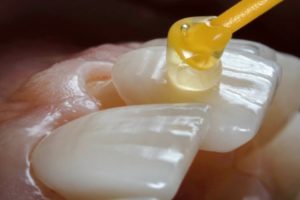
If you suffer from chips, cracks, stains, or gaps in your smile, you probably find yourself feeling self-conscious in photographs or tending to try to hide your teeth. The great news is, you don’t have to continue to deal with the frustration of flaws in your smile. Both porcelain veneers and Lumineers are great options when it comes to smile transformation, but how do you know which procedure is right for you? Keep reading to learn how they differ and what kinds of things you should consider when choosing between the two.
Porcelain Veneers
You may have also heard these referred to as “porcelain laminates,” and they are used for a number of purposes. Here are a few details about porcelain veneers:
- They are a permanent solution for dental flaws such as chips, gaps, cracks, or stains that are too dark to be affected by a professional whitening treatment.
- They are made of paper-thin, extremely strong, and resilient porcelain material that your dentist will color-match to your surrounding natural teeth.
- Prior to attachment, your dentist will have to alter the natural tooth by reducing the surface area of it, much like a nail technician will run a drill over a fingernail prior to placing an acrylic false nail over it. This reduction can be as much as 0.5 millimeters.
- Your dentist will have to extensively prepare the veneers to make sure that they are flush against your gumline. This will sometimes mean trying multiple different temporary prosthetics before placing the permanent veneer on.
Lumineers
Now that you understand the basics of porcelain veneers, here are some facts about Lumineers and how they are similar, but also different.
- Like veneers, Lumineers are also used to mask flaws that affect the look of your natural teeth, such as gaps, chips, etc.
- While veneers are most commonly made from porcelain, Lumineers are created using a patented material known as Cerinate, which will appear thicker against the tooth than porcelain veneers.
- Unlike porcelain veneers, your dentist will not have to alter your natural tooth prior to placing the permanent veneer on, which makes the entire process much quicker.
- Although Lumineers are similar to veneers in a lot of ways, it’s important to note that due to the different materials and shorter procedure time, they often will not last as long as porcelain veneers.
Knowing the differences between porcelain veneers and Lumineers can help you figure out what your goals are for your personal smile transformation. Talk to your dentist about your unique needs and let them help you decide on the best option.
About the Author
When it comes to top-notch cosmetic dentistry, you won’t find a better team than Dr. M. Faizan Ali and Dr. Naira T. Kraipak at Plush Dentistry. They are committed to making sure that each of their patients has the opportunity to have the smiles of their dreams, and they have helped many achieve this through porcelain veneers. Combined years of training and experience equip them to provide the highest quality of care. Are you ready to transform your smile? Schedule your appointment online or call (469) 850-0786.